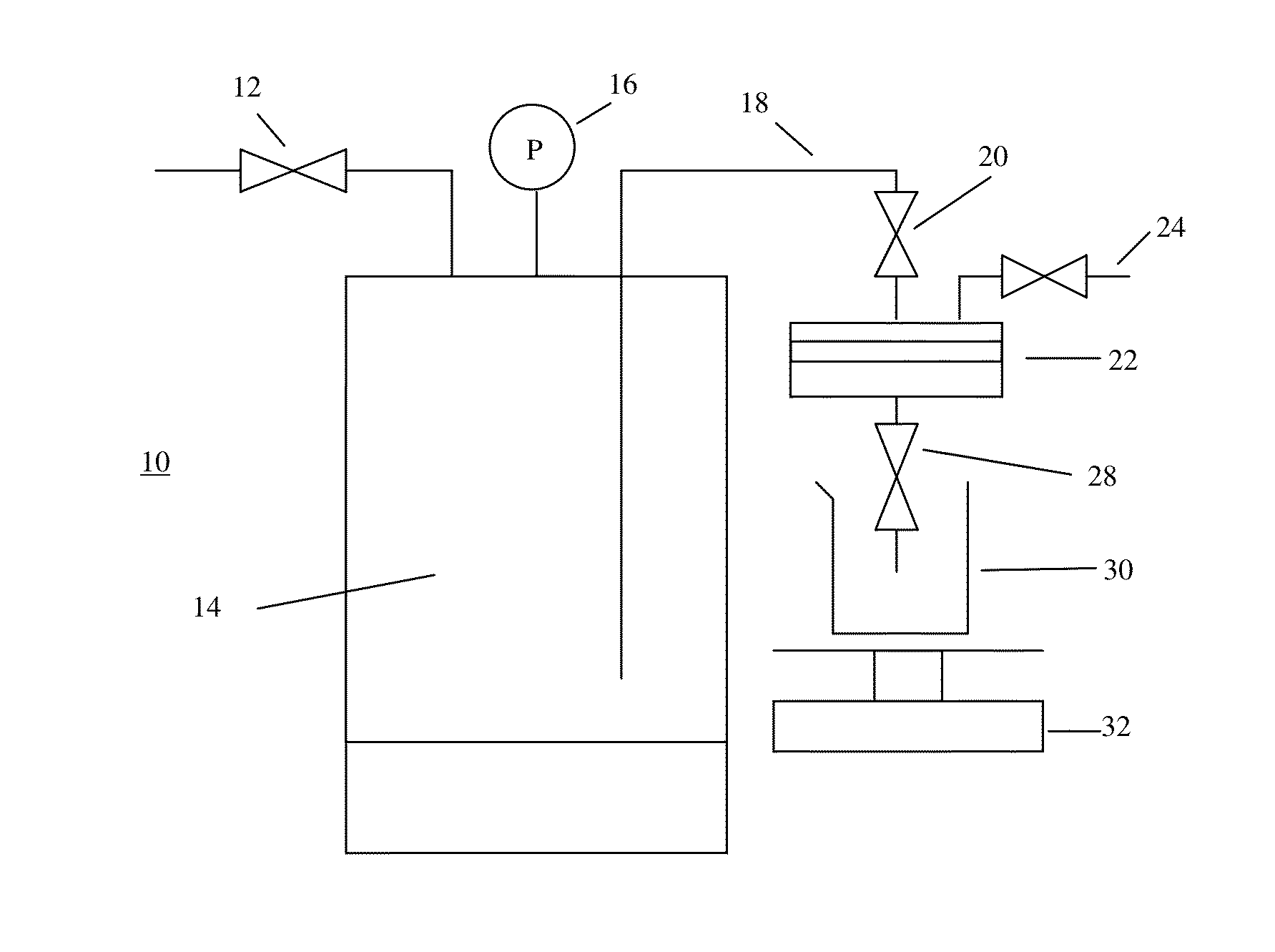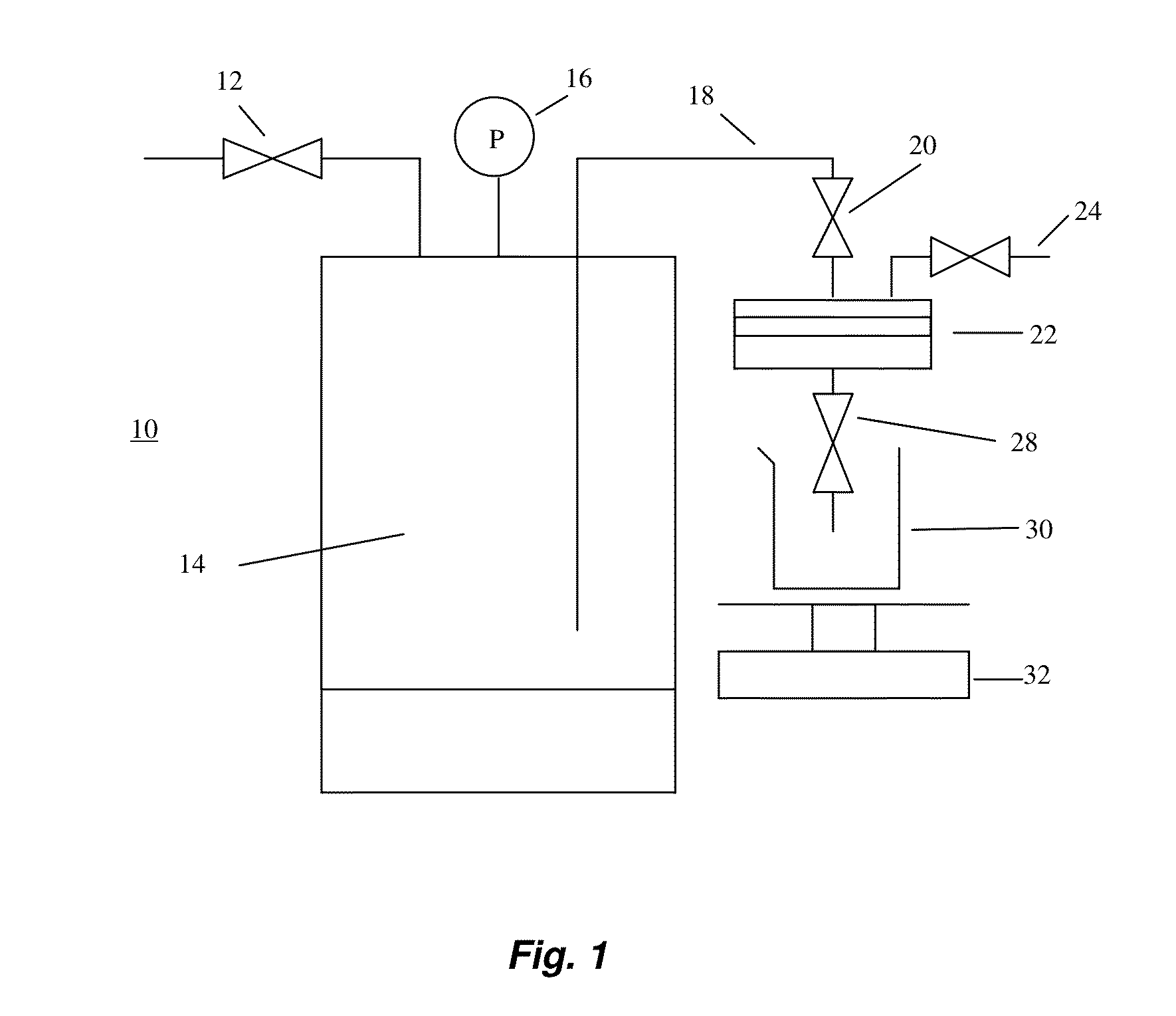Composite material
- Summary
- Abstract
- Description
- Claims
- Application Information
AI Technical Summary
Benefits of technology
Problems solved by technology
Method used
Image
Examples
example 1
5% PVPP / Vyon® Composite
[0136]The composite comprised polyethylene (Vyon®, available from Porvair Filtration Group Ltd) co-sintered with polyvinylpolypyrrolidone (PVPP) (Polyclar® 10; available from ISP Corporation) that consists of particles of approximately 25 μm in diameter. The components were co-sintered at a temperature of 180±5° C. (oven temperature 245° C.) for 6 minutes.
[0137]The composite produced was robust. The mass of the disc was 3.097 g following removal of loose material from the surface of the disc. The disc was approximately 2.7 mm thick. Flow rates through the disc were as high as 170 ml / min (81 hl / hr / m2) at 100 mbar pressure difference, hence downstream flow had to be markedly reduced at 0.5 bar, in order to allow sufficient contact / residence time for the beer.
[0138]As shown in FIGS. 2 and 3, there is initially a marked reduction in the tannoid content. The material then becomes exhausted.
[0139]The quantity of PVPP available in the disc was approximately 0.1549 g,...
example 2
10% PVPP / Vyon® Composite
[0140]The composite comprised polyethylene (Vyon®, available from Porvair Filtration Group Ltd) co-sintered with polyvinylpolypyrrolidone (PVPP) (Polyclar® 10; available from ISP Corporation) that consists of particles of approximately 25 μm in diameter. The components were co-sintered at a temperature of 180±5° C. (oven temperature 245° C.) for 6 minutes.
[0141]The composite was not robust; initial experiments to examine flow vs. pressure characteristics resulted in breakage of the composite at greater than 1 bar pressure difference. An intact disc was used for the stabilisation studies. Flow rates through the composite were 17.7 hl / hr / m2 at 0.6 bar pressure in the pressure vessel. The mass of the disc was 3.2 g with a thickness of 2.5 mm.
[0142]As shown in FIGS. 4 and 5, there is no significant reduction in the stabilisation throughout the experiment. The quantity of PVPP in the composite amounted to 0.32 g, hence the dosage for the total amount of beer treat...
example 3
Experiments with Three 5% PVPP / Vyon® Discs Stacked Vertically
[0145]The experiment was performed with three composite discs stacked vertically in the holder. The total mass of the three composite discs was 9.06 g, containing 0.453 g of PVPP.
[0146]There was an opportunity for bypassing to occur, between the first and final disc. Flow rates were 413 ml / min at 0.5 bar pressure, however, as aforementioned some bypassing did occur, and therefore precise values could not be obtained.
[0147]As shown in FIGS. 6 and 7, there is a marked reduction in the tannoid content throughout the experiment. Low levels of tannoids were recorded from the samples: the dosage of PVPP for the total volume was 41.2 g of PVPP / hl.
PUM
| Property | Measurement | Unit |
|---|---|---|
| Fraction | aaaaa | aaaaa |
| Fraction | aaaaa | aaaaa |
| Fraction | aaaaa | aaaaa |
Abstract
Description
Claims
Application Information
 Login to View More
Login to View More - R&D
- Intellectual Property
- Life Sciences
- Materials
- Tech Scout
- Unparalleled Data Quality
- Higher Quality Content
- 60% Fewer Hallucinations
Browse by: Latest US Patents, China's latest patents, Technical Efficacy Thesaurus, Application Domain, Technology Topic, Popular Technical Reports.
© 2025 PatSnap. All rights reserved.Legal|Privacy policy|Modern Slavery Act Transparency Statement|Sitemap|About US| Contact US: help@patsnap.com



